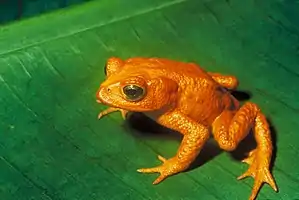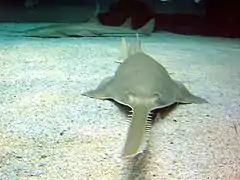Critically Endangered
An IUCN Red List Critically Endangered (CR) species is one that has been categorized by the International Union for Conservation of Nature as facing an extremely high risk of extinction in the wild.[1] As of 2021, there are 6,811 species that are considered to be Critically Endangered.[2] This is out of the 120,372 species currently tracked by the IUCN.
| Conservation status | |
|---|---|
 | |
| Extinct | |
| Threatened | |
| Lower Risk | |
Other categories | |
| |
Related topics
| |
 Comparison of Red list classes above and NatureServe status below  | |
The IUCN Red List provides the public with information regarding the conservation status of animal, fungi, and plant species.[3] It divides various species into seven different categories of conservation that are based on habitat range, population size, habitat, threats, etc. Each category representing a different level of global extinction risk. Species that are considered to be Critically Endangered are placed within the "threatened" category[4]
As the IUCN Red List does not consider a species extinct until extensive, targeted surveys have been conducted, species that are possibly extinct are still listed as Critically Endangered. IUCN maintains a list[5] of "possibly extinct" and "possibly extinct in the wild" species, modelled on categories used by BirdLife International to categorize these taxa.
Criteria for Critically Endangered Species
To be defined as Critically Endangered in the Red List, a species must meet any of the following criteria (A–E) ("3G/10Y" signifies three generations or ten years—whichever is longer—over a maximum of 100 years; "MI" signifies Mature Individuals):[6]
- A: Population Size Reduction
- The rate of reduction is measured either over a 10 year span or across three different generations within that species.
- The cause for this decline must also be known.
- If the reasons for population reduction no longer occur and can be reversed, the population needs to have been reduced by at least 90%
- If not, then the population needs to have been reduced by at least 80%
- B: Reduction Across a Geographic Range
- This reduction must occur over less than 100 km2 OR the area of occupancy is less than 10 km2.
- Severe habitat fragmentation or existing at just one location
- Decline in extent of occurrence, area of occupancy, area/extent/quality of habitat, number of locations/subpopulations, or amount of MI.
- Extreme fluctuations in extent of occurrence, area of occupancy, number of locations/subpopulations, or amount of MI.
- This reduction must occur over less than 100 km2 OR the area of occupancy is less than 10 km2.
- C: Population Decline
- The population must decline to less than 250 MI and either:
- A decline of 25% over 3G/10Y
- Extreme fluctuations, or over 90% of MI in a single subpopulation, or no more than 50 MI in any one subpopulation.
- The population must decline to less than 250 MI and either:
- D: Population Size Reduction
- The population size must be reduced to numbers of less than 50 MI.
- E: Probability of Extinction
- There must be at least a 50% probability of going extinct in the wild within over 3G/10Y
Causes
The current extinction crisis is witnessing extinction rates that are occurring at a faster rate than that of the natural extinction rate. It has largely been credited towards human impacts on climate change and the loss of biodiversity. This is along with natural forces that may create stress on the species or cause an animal population to become extinct.[7] The main causes for Critically Endangered species is the following.
- Loss of Habitat
- This is considered to be one of the most significant reasons animals and plants become endangered.
- Species rely on their habitat for the resources needed for their survival. If the habitat becomes destroyed, the population will see a decline in their numbers.
- Some activities that cause habitat loss is:
- Climate change
- Geologic change
- Human migration
- Highway construction
- Urbanization
- Agriculture
- Introduction of Invasive Species
- Invasive species invade and exploit a new habitat for its natural resources as a method to outcompete the native organisms, eventually taking over the habitat.
- This can lead to either the native species' extinction or causing them to become endangered.
- Disease
- The introduction of a disease into a new habitat can cause it to spread amongst the native species.
- Due to their lack of familiarity with the disease or little resistance, the native species can die off.
- This will cause the population's numbers to be reduced.
- Environmental Pollution
- Pollution is harmful to both the species and habitat.
- This can cause the population's numbers to be reduced.
- Pollution can be in the form of:
- Air
- Light
- Noise
- Pesticides
- Chemicals
- Depletion of Natural Resources
- If resources become overexploited and depleted, there is no longer enough resources to sustain the native species of this habitat.
- Hunting/Fishing
- Overhunting/overfishing of a certain species can cause other species who prey on that particularly species to starve.
- Overhunting/overfishing of a certain species can also cause them to become endangered due to population depletion.
Conservation
A high percentage of species have become extinct and are considered to be Critically Endangered. Conservation methods are necessary in order to provide relief and recovery for species that are facing extinction. This is due to the declining rate of biodiversity as ecosystems collapse alongside its extinct and Critically Endangered species. It would take years before another species population would return to the habitat and increase its biodiversity rate. Conservation methods such as the following allow for human imposed threats of these Critically Endangered species to be lessened.
- Educate Yourself and Others
- This is considered to be one of the most essential conservation methods.
- By learning about wildlife, you are better able to understand the importance of these endangered species and the resources needed for their survival.
- This can either be learning the wildlife in your local neighborhood or across different nations.
- You can then educate friends, family, and neighbors on information regarding various local and global species.
- This includes activities such as:
- Visiting a national wildlife refuge or park
- Volunteering
- Observe the plants and animals around you
- This is considered to be one of the most essential conservation methods.
- Recycle and Use Sustainable Products
- Recycling helps to reduce the amount of plastic waste that ends up in both the marine and terrestrial ecosystems.
- Using more sustainable products that allows for repetitive use will prevent the amount of trash and recycling waste that ends up in our environment.
- Encourage Wildlife-Friendly Practices in Your Neighborhood
- This includes cleaning objects that is used by communities of animals in order to prevent disease transmission,
- Example: bird baths and hummingbird feeders
- Ensure that garbage cans are closed so that animals cannot be attracted towards it.
- Also, ensuring that food is not left outdoors and areas with water are main.
- Maintain the speed limit of your neighborhood to avoid accidentally killing any animals. This may limit the reduction of a native species population size within a certain area if it is a common occurrence within this species.
- This includes cleaning objects that is used by communities of animals in order to prevent disease transmission,
- Monitor Your Chemical Usage
- Try to avoid using harsh chemicals, herbicides, and pesticides as they have been known to degrade the soil within its surrounding environment.
- High levels these pollutants can be considered as threatening or even toxic to native species.
- Do Not Engage in Illegal Wildlife Captivity
- Poaching not only decreases the population's numbers, but also disrupts the balance of a certain habitat. This is due to the fact the certain species are considered to be assets to their environment as they provide it with natural resources. By poaching off a particular species, you may be depriving the habitat of the resources needed to sustain its other native animal and plant species.
- Poached animals have also been known to introduce and spread disease amongst human populations through wildlife trade. This can also affect the health of an environment by threatening its native species populations.[8]
- Develop Protective and Relief Projects for Threatened Species
- The Endangered Species Act was signed into law in 1973 by Richard Nixon in order to protect animals and plants who were facing possible extinction after an already visible decline of several species in the 1900s.
- This is intended to allow species to recover to the point where they no longer need protection.
- The U.S. Fish and Wildlife Service created the relief program "Critically Endangered Animals Conservation Fund" to send funding to continents such as Africa, Asia, South America, and Oceania to create projects that provide assistance with the recovery of Critically Endangered species from the brink of extinction.[9]
- The Endangered Species Act was signed into law in 1973 by Richard Nixon in order to protect animals and plants who were facing possible extinction after an already visible decline of several species in the 1900s.
References
- "IUCN RED LIST CATEGORIES AND CRITERIA" (PDF). 2000-02-09. Retrieved 2018-02-06.
- "IUCN Red List of Threatened Species". IUCN. Retrieved August 21, 2020.
- "What is The IUCN Red List?". IUCN Red List. Retrieved August 13, 2020.
- "Endangered Species". National Geographic. March 17, 2011. Retrieved August 13, 2020.
- "Summary Statistics". www.iucnredlist.org. Retrieved 2017-12-10.
- IUCN (February 2014). "Guidelines for Using the IUCN Red List Categories and Criteria" (PDF). Archived from the original (PDF) on 2 May 2015. Retrieved 10 December 2018.
- Chandler, David (November 22, 2019). "What Are the Causes of Animals Becoming Endangered?". Sciencing. Retrieved August 20, 2020.
- Karesh, William (July 2005). "Wildlife Trade and Global Disease Emergence". NCBI. Retrieved August 24, 2020.
- "Critically Endangered Animals Conservation Fund". U.S. Fish and Wildlife Service. Retrieved August 24, 2020.
.jpg.webp)



